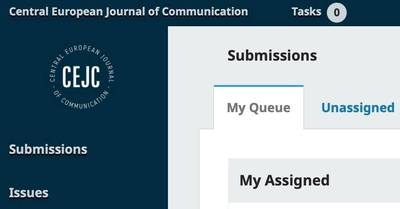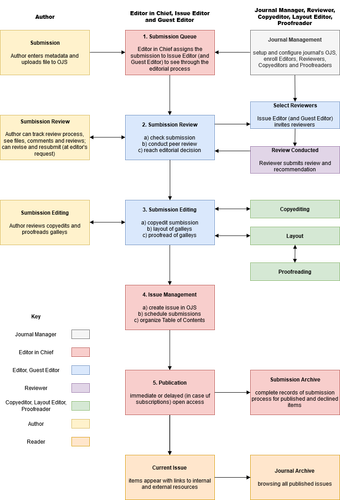An Introduction to Open Journal Systems

The Open Journal Systems (OJS) is a specialized, open source software application dedicated to scientific journals. The system, created in 2001 in Canada by the Public Knowledge Project, allows for convenient journal management. OJS is currently the most-used tool for publishing houses of scientific journals. It is an undeniable standard, used by over 8,000 open access titles around the world. The CEJC Editorial Team hopes to join this group starting from the Spring 2021 issue, and thus contribute to the development of global universal access to knowledge.
The idea behind this software development is not only to improve the publication process but also to promote scientific journals by increasing their readership, creating a space for scientific communication, improving the quality of publications and supporting open access to scientific research. The software is based on the GPLv2 license, which means that it can be downloaded, used and, if necessary, modified free of charge.
The main advantage of using OJS is the streamlining of the submission and editorial workflow. The system provides the technical infrastructure that supports scientific journals from the moment the author submits the text, through the peer-review and publishing process, to indexing. The tool introduces a clear and transparent division of users into e.g. readers, authors, reviewers and editors, thus giving each group appropriate rights within the system. By integrating the indicated roles within one platform dedicated to the entire publishing process, OJS enables and significantly improves the electronic system of submitting, reviewing and publishing articles.
Authors benefit primarily from the increased citation and visibility of their publications. Moreover, the intuitive user interface makes communication with the editors much easier, and all publication data is collected in one place. The author can follow-up on reviews, manage files and control the entire progress of online editorial work. OJS makes it easier for authors to deposit manuscripts, introduce metadata and refer to amendments proposed by the editor and reviewers.
Thanks to the use of OJS by the reviewer to evaluate the submitted article, all the activities performed are more efficient and much more automated. A helpful function is, for example, the visible schedule of the review process, which additionally positively affects the timeliness of the reviews being prepared: it contains all the necessary deadlines from the review process, including the deadline for responding to an invitation to the review and the deadline for submitting the review. An interesting feature of OJS is the option to send copies of the article files after the review, with comments or corrections [1]. The reviewer can also write additional notes in OJS: both for the author and editorial team, or only for the editorial team. Another strength of OJS is that the reviewer may verify if the suggested corrections have been inserted by the author.

Diagram 1. The publishing process in OJS.
Source: Own work based on: T. Maleńczuk, „Open Journal Systems” [in:] „Biuletyn EBIB”, B. Bednarek-Michalska (Ed.in Ch.), no 2/2009 (102) March, Warsaw: Stowarzyszenie Bibliotekarzy Polskich KWE, 2010, online: http://www.ebib.info/2010/102/a.php?malenczuk
However, OJS is a platform primarily facilitating editorial work by remote management of the publishing process, especially since its operation is relatively intuitive and takes place via a web browser [2]. The presented functionalities of the tool also clearly indicate that OJS enables the implementation of a comprehensive and fully configurable system of article reviews, allowing for the verification of the quality and timeliness of their submissions and contributing to the creation of a reviewer database. Furthermore, OJS also ensures efficient communication between users of the platform, both internal (as part of a discussion on a specific article) and external (the possibility of sending e-mail messages, creating mailing lists), which significantly facilitates the work of the editorial team.
The benefits of using OJS also include the fact that the content of a journal edited using this tool is automatically indexed by Google Scholar. Thanks to the possibility of installing additional plug-ins, OJS also enables the transfer of metadata, which means the actual integration of the journal with indexing systems in selected databases. Moreover, the available plugins enable the integration of OJS with numerous publishing services such as Crossref, ORCiD and DOAJ. From a technical point of view, useful functionalities of this platform include the event log, statistical and reporting features, and – above all – the possibility of making the final composition of the issue for publication.
Although there are several alternatives to OJS on the market of systems for managing the publishing process in journals, some of them (paid) are intended rather for commercial entities, and the rest (free) is not very popular – due to a low number of implementations, their groups of authors, reviewers and editors are not large. In this case, the undoubted advantages of OJS are its multilingualism (so far, the platform has been translated into over 30 languages), the responsive reader interface and the support from the user community.
The global development of technology influences changes in science, not only in terms of research but also in terms of presenting its results, especially in the form of scholarly publications. One of the outcomes of this process is the progressive digitalisation of scientific journals. There is no doubt that content management systems, such as OJS implemented by CEJC, are becoming an increasingly common companion of the current submission and editorial process and at the same time a symbol of modern publishing, thus being the future of any scientific journal. We are proud to announce that for both “Central European Journal of Communication” and “Com.press”, a fellow scientific journal published by the Polish Communication Association, the future is now.
Dagmara Sidyk
UNIVERSITY OF WARSAW, POLAND
Roksana Zdunek
JAGIELLONIAN UNIVERSITY, CRACOW, POLAND
[1] Before uploading the file, the reviewer should ensure that all hidden data and personal information are removed.
[2] After prior installation of the platform on the server (e.g. publishers’).